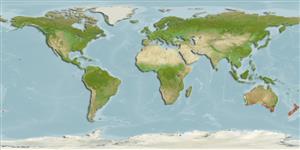Environment: milieu / climate zone / depth range / distribution range
Ecology
Marine; benthopelagic; depth range 0 - 33 m (Ref. 84085), usually 10 - ? m (Ref. 84085). Temperate
Southwest Pacific: Tasmania, Australia and New Zealand, including the Chatham Islands.
Size / Weight / Age
Maturity: Lm ? range ? - ? cm
Max length : 13.0 cm SL male/unsexed; (Ref. 13227); max. reported age: 4 years (Ref. 31614)
Short description
Identification keys | Morphology | Morphometrics
Dorsal spines (total): 26 - 32; Dorsal soft rays (total): 12 - 16. Head and pectoral fin base scaly (latter covered with cycloid scales), no scales on third dorsal fin membrane, ctenoid scales adjacent to but not overlapping base of third dorsal fin membrane. Lateral line scales short, posterior projection absent (present in specimens <88mm). Dorsal fin formula V-0N-0-1-0-1. Parhypural not fused. Nine procurrent rays in upper lobe, eight in lower lobe; in upper lobe, one procurrent ray opposite upper lobe, six opposite two epurals, two anterior to anterior epural; in lower lobe, one procurrent ray opposite lower lobe, six opposite haemal spine of second preural vertebra, one between haemal spine of second preural vertebra and haemal spine of third preural vertebra. Body with seven vertical bands of reddish-brown to black saddles (broad bands not extending onto ventral surface) (Ref. 84085).
Facultative air-breathing in the genus (Ref. 126274); Adults are generally more abundant above 10m, but common in areas of broken rock on reefs, rock pools and sub-tidally down to 33 m (Ref. 84085). They feed on benthic invertebrates. Spawning occurs from May to November (Ref. 9003). Eggs are hemispherical and covered with numerous sticky threads that anchor them in the algae on the nesting sites (Ref. 240). Larvae are planktonic which occur primarily in shallow, nearshore waters (Ref. 94114).
Life cycle and mating behavior
Maturities | Reproduction | Spawnings | Egg(s) | Fecundities | Larvae
Paulin, C. and C. Roberts, 1992. The rockpool fishes of New Zealand (Te ika aaria o Aotearoa). Museum of New Zealand (Te Papa Tongarewa). 177 p. (Ref. 9003)
IUCN Red List Status (Ref. 130435)
Threat to humans
Harmless
Human uses
Tools
Special reports
Download XML
Internet sources
Estimates based on models
Preferred temperature (Ref.
123201): 10.6 - 20.3, mean 16.5 °C (based on 422 cells).
Phylogenetic diversity index (Ref.
82804): PD
50 = 0.5039 [Uniqueness, from 0.5 = low to 2.0 = high].
Bayesian length-weight: a=0.00692 (0.00366 - 0.01307), b=3.08 (2.91 - 3.25), in cm total length, based on LWR estimates for this species & (Sub)family-body (Ref.
93245).
Trophic level (Ref.
69278): 3.5 ±0.4 se; based on diet studies.
Resilience (Ref.
120179): Medium, minimum population doubling time 1.4 - 4.4 years (Tmax=4; K=1.85).
Fishing Vulnerability (Ref.
59153): Low vulnerability (10 of 100).
Nutrients (Ref.
124155): Calcium = 106 [54, 255] mg/100g; Iron = 0.561 [0.275, 1.110] mg/100g; Protein = 17.5 [16.3, 18.7] %; Omega3 = 0.409 [0.166, 1.002] g/100g; Selenium = 16.2 [6.1, 44.7] μg/100g; VitaminA = 14.7 [2.9, 74.4] μg/100g; Zinc = 1.15 [0.70, 1.79] mg/100g (wet weight);
